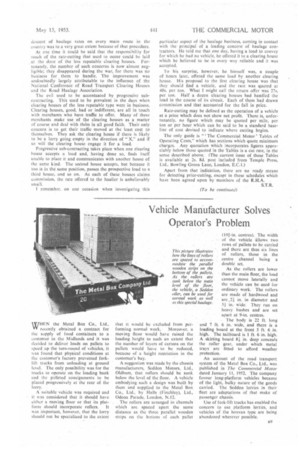Vehicle Manufacturer Solves Operator's Problem
Page 43

If you've noticed an error in this article please click here to report it so we can fix it.
WHEN the Metal Box Co., Ltd., VI' recently obtained a contract for the supply of food containers to a customer in the. Midlands and it was decided to deliver loads on pallets to speed up the turn-round of vehicles, it was found that physical conditions at the customer's factory prevented forklift trucks from unloading at ground level. The only possibility was for the trucks to operate on the loading bank and the palleted consignments to be placed progressively at the rear of the lorry. • A suitable vehicle was required and it was considered that it should have either a moving floor or that its plat form should incorporate rollers. It was important, however, that the lorry should not be specialized to the extent that it would be excluded from performing normal work. Moreover, a moving floor would have raised the loading height to such an extent that the number of layers of cartons on the pallets would have to he reduced, because of a height restriction in the customer's bay.
A suggestion was made by the chassis manufacturers, Seddon Motors, Ltd., Oldham, that rollers should be sunk below the level of the floor. A vehicle embodying such a design was built by them arid supplied to the Metal Box Co., Ltd., by Halls (Finchley), Ltd., Odeon Parade, London, N.I2.
The rollers are arranged in channels which are spaced apart the same distance as the three parallel wooden strips on the bottom of each pallet (19I-in. centres). The width of the vehicle allows two rows of pallets to be carried and there are thus six lines of rollers, those in the centre channel being a double set.
As the rollers are lower than the main floor, the load cannot move laterally and the vehicle can be used for ordinary work. The rollers are made of hardwood and are,21 in. in diameter and 31 in.. wide. They run on heavy bushes and are set apart at 9-in. centres.
The body is 22 ft. long and 7 ft. 6 in. wide, and there is a loading board at the front 5 ft. 6 in. high. The tailboard is 1 ft. 6 in. high. A skirting board 81 in. deep conceals the roller gear, under which metal trays are fitted to afford weather protection.
An account of the road transport system of the Metal Box Co., Ltd., was published in The Commercial Motor dated January 11, 1952. The company favour long-platform vehicles because of the light, bulky nature of the goods carried. The Seddon lorries in their fleet are adaptations of that make of passenger chassis.
Use of fork-lift trucks has enabled the concern to use platform lorries, and vehicles of the boxvan type are being abandoned wherever possible.




























































































